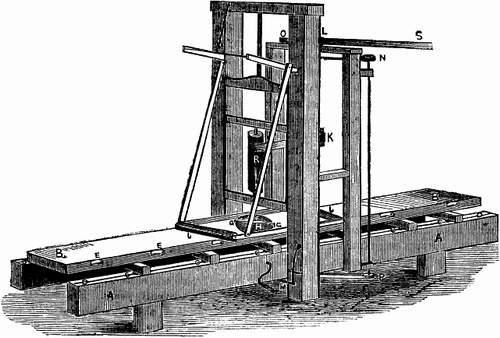In 1834, Daniels patented a machine face-jointer that was, at least in America, the first successful mechanization of the process of flattening boards and lumber. His design was used for many years, often in combination with the Woodworth planer, which machined a second face parallel to the first. The Woodworth planer could not be used by itself to create a flat face, because the pressure of the feed rollers tended to flatten the board, which would spring back after it had been planed.

Engraving of Daniels planer from 4 November 1848 "Scientific American"
The Daniels planer consisted of a reciprocating carriage on which the lumber was secured; the lumber was shimmed as necessary so that it could not rock or twist while being planed. A pair of cutters were mounted on either end of a horizontal bar that was suspended from a vertical spindle above the stock. This vertical spindle rotated rapidly, removing material from the stock so that the upper face of the stock is flattened (except for circular score marks similar to those left behind by a circular saw). This design is a simplified version of Joseph Bramah's planer that was patented in England in 1802.
For an awe-inspiring look at what a Daniels planer must have been like to see in operation, see the pictures and article at the Maine Maritime Museum website.
The Daniels planer was superseded by the modern jointer, invented by Climer & Riley in 1866, although Daniels planers remained useful for longer stock, such as spars and masts for wooden ships. Daniels planers were manufactured as late as 1900. One of the major disadvantages of the Daniels planer in comparison to the jointers that superseded it is the floor space taken up: a Daniels planer is more than twice the length of the longest board it can handle.
In contrast to William Woodworth and his backers, Daniels not only did not try to renew his patent, he never took anyone to court over patent infringement.
The book Planers, Matches and Molders in America, by Chandler W. Jones, reports that Daniels manufactured his machines himself, plus he licensed his design to others. The following companies (and undoubtedly many others) made Daniels' patent planers; some of them probably only did so after Daniels' patent had expired:
Daniels started manufacturing his planer shortly after the patent was granted, and he continued to manufacture it until 1848, when he sold his business to his foreman, Richard Ball, and another man, Thomas Rice. These two operated as Ball & Rice until 1854, and then the name changed to Ball & Ballard until 1858, then Ball & Williams until 1865, then R. Ball & Co. until 1873 when Ball died. The remains of the company were purchased by Witherby, Rugg & Richardson. Thomas E. Daniels died in Fitchburg, MA, in 1884.
Several Daniels-style planers survive; one of them is a J. A. Fay & Co. model that is at the Smithsonian. The Percy & Small shipyard mill at the Maine Maritime Museum has a Richardson, Meriam & Co. planer, as does the Slater Mill Historic Site in Pawtucket, RI. The American Precision Museum at Windsor, VT, (at least used to) have a Daniels-type planer on display, as did the Henry Ford Museum at Dearborn, MI.
Information Sources
- The Daniels patent
- Planers, Matchers and Molders in America notes that Daniels planers were made as late as 1900, and traveling-carriage planers were made as late as World War II (for planing spars and masts for wooden ships such as minesweepers; the makers were Stetson-Ross and L. Power & Co.).
- A descendant of Thomas E. Daniels reports seeing a planer made by his great-grandfather at the American Precision Museum at Windsor, VT; he also reports seeing a Daniels planer at the Henry Ford Museum at Dearborn, MI. Both of these sightings were several years ago.
- The journal "Collections of the Worcester Society of Antiquity, Vol. VI", 1885, carried an article titled "The manufacture of lumber, and its use in house building", by Ellery B. Crane:
[The beginning of wood-working manufacturing in Worcester] dates from 1835 or 6, just after Mr. Thomas E. Daniels received the patent for his planing machine, when he began to manufacture them at the old Court Mills, and where he continued to produced them (with the exception of the year the mills were rebuilding after being destroyed by fire) until the year 1848, when he sold the business to Mr. Richard Ball (Mr. Daniels removed to Fitchburg, where he died early in the present year.) At this time 35 to 40 men were employed in turning out the Daniels planer. I am told that Mr. Thomas H. Rice was for a time engaged with Mr. Ball, the firm being Ball & Rice; afterwards Mr. Warren Williams took the interest of Mr. Rice, and the style was Ball and Williams. Later the business was conducted under the firm name of R. Ball & Co.; and they were succeeded by the present popular firm of Witherby, Rugg & Richardson. From this old historical house have sprung the other firms engaged in the manufacture of wood-working machinery in this city."
- Fireside Legends, 1900, by William Andrew Emerson, mentions "Thomas E. Daniels, 1880-84. Inventor of the Daniels planer; native of Fitchburg. Moved to Woodstock, Vt. in 1829, to Worcester 1844, to Fitchburg in 1848..."